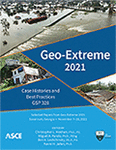Brooklyn Beachfront Towers in a Post-Super Storm Sandy World
Publication: Geo-Extreme 2021
ABSTRACT
Located near the western tip of Coney Island, 3514 Surf Avenue includes two 20- and 22-story towers, a three- to five-story podium, and an attached garage. This paper describes the numerous challenges that arose during design and construction, including complex soil conditions, strict settlement tolerances, aggressive design criteria, and flood concerns magnified by Hurricane Sandy. High-foundation loads under the towers, combined with a deep compressible clay layer [65–105 ft (20–32 m) below grade], would have resulted in unacceptable settlement of the towers if shallow foundations were used. However, the relatively light garage loads did not present settlement issues and therefore did not warrant expensive pile foundations. To address differential settlement between the towers and garage, the geotechnical and structural engineers proposed a hybrid foundation system of pile foundations under the towers and spread footings under the garage. The interaction and settlement at the interface of the two foundation types were considered while designing this cost-effective solution that satisfied serviceability requirements. Multiple rounds of subsurface explorations (16 test borings, 11 CPT probes, and 22 test pits), index-pile driving (20 piles), and pile load testing (40 PDAs, 22 CAPWAPs, five compression load tests, and three lateral load tests) were performed during the design phase to optimize the foundations. The project team considered different pile types and sizes during the index-pile program as recommended by the geotechnical engineer and foundation contractor.
Get full access to this article
View all available purchase options and get full access to this chapter.
REFERENCES
Moss, C. J. (2014). The Problem Posed by New York’s “20-Foot Clay”: Which is Wrong – Published Dates, Presumed Glacial Events, or Strata Origins?, 22th Annual Conference on Geology of Long Island and Metropolitan New York, 11 April 2014, State University of New York at Stony Brook, NY, Long Island Geologists Program with abstracts, 13 p.
Moss, C. J., and Canale, T. D. (2017). Mapping the 20-Foot Clay (Wantagh Formation)in Queens and Brooklyn, New York, in Hanson, G.N., Chm., 23rd Annual Conference on Geology of Long Island and Metropolitan New York, 8 April 2017, State University of New York at Stony Brook, NY, Long Island Geologists Program with Abstracts, 11 p.
Reese, L. C. (1990). The Action of Soft Clay Along Friction Piles; Bay Mud Revisited, Proceedings of the Memorial Symposium in honor of Professor Harry Bolton Seed, II: 134–153, University of California, Berkeley
NYC Mayor’s Office of Recovery and Resiliency. (2018). Climate Resiliency Design Guidelines, April 2018, Version 2.0.
FEMA (Federal Emergency Management Agency). Preliminary Flood Insurance Rate Map (FIRM) for City of New York, 5 December 2013.
Peer, A. (2018). “2012 Hurricane Sandy: Facts, FAQs, and how to help” World Vision <https://www.worldvision.org/disaster-relief-news-stories>(Feb. 8, 2021).
Information & Authors
Information
Published In
Copyright
© 2021 American Society of Civil Engineers.
History
Published online: Nov 4, 2021
Authors
Metrics & Citations
Metrics
Citations
Download citation
If you have the appropriate software installed, you can download article citation data to the citation manager of your choice. Simply select your manager software from the list below and click Download.
